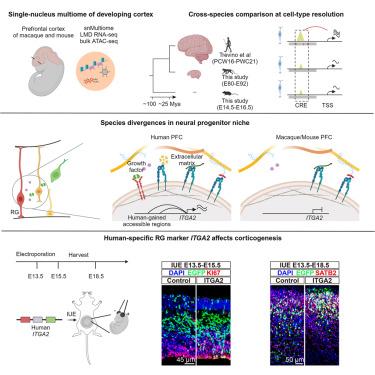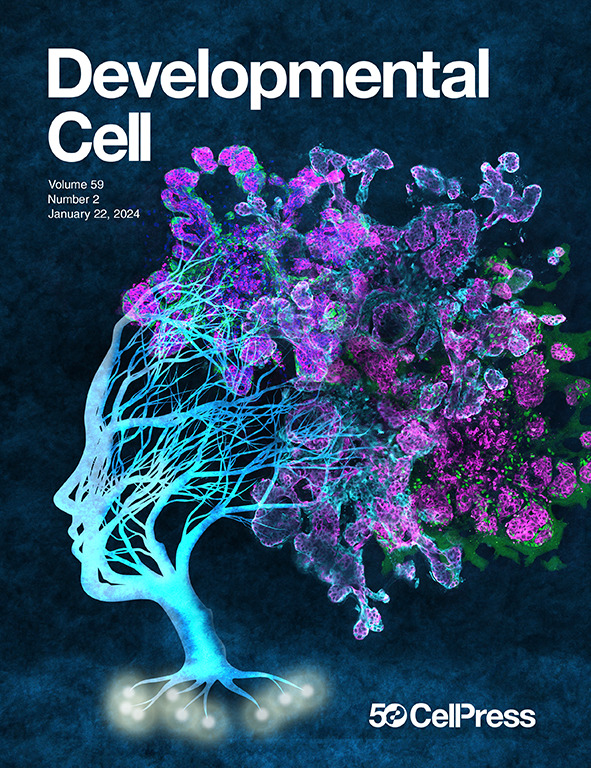Comparative single-cell multiome identifies evolutionary changes in neural progenitor cells during primate brain development
IF 10.7
1区 生物学
Q1 CELL BIOLOGY
引用次数: 0
Abstract
Understanding the cellular and genetic mechanisms driving human-specific features of cortical development remains a challenge. We generated a cell-type resolved atlas of transcriptome and chromatin accessibility in the developing macaque and mouse prefrontal cortex (PFC). Comparing with published human data, our findings demonstrate that although the cortex cellular composition is overall conserved across species, progenitor cells show significant evolutionary divergence in cellular properties. Specifically, human neural progenitors exhibit extensive transcriptional rewiring in growth factor and extracellular matrix (ECM) pathways. Expression of the human-specific progenitor marker ITGA2 in the fetal mouse cortex increases the progenitor proliferation and the proportion of upper-layer neurons. These transcriptional divergences are primarily driven by altered activity in the distal regulatory elements. The chromatin regions with human-gained accessibility are enriched with human-specific sequence changes and polymorphisms linked to intelligence and neuropsychiatric disorders. Our results identify evolutionary changes in neural progenitors and putative gene regulatory mechanisms shaping primate brain evolution.

单细胞多组比较确定灵长类动物大脑发育过程中神经祖细胞的进化变化
了解驱动大脑皮层发育的人类特异性特征的细胞和遗传机制仍然是一项挑战。我们在发育中的猕猴和小鼠前额叶皮层(PFC)中生成了细胞类型解析的转录组图谱和染色质可及性图谱。与已发表的人类数据相比,我们的研究结果表明,尽管大脑皮层的细胞组成在不同物种间总体上是一致的,但祖细胞在细胞特性上却表现出显著的进化差异。具体来说,人类神经祖细胞在生长因子和细胞外基质(ECM)通路中表现出广泛的转录改组。在胎鼠皮质中表达人类特异性祖细胞标记 ITGA2 会增加祖细胞的增殖和上层神经元的比例。这些转录差异主要是由远端调控元件活性的改变驱动的。人类获得的染色质区域富含与智力和神经精神疾病相关的人类特异性序列变化和多态性。我们的研究结果确定了神经祖细胞的进化变化以及塑造灵长类大脑进化的潜在基因调控机制。
本文章由计算机程序翻译,如有差异,请以英文原文为准。
求助全文
约1分钟内获得全文
求助全文
来源期刊

Developmental cell
生物-发育生物学
CiteScore
18.90
自引率
1.70%
发文量
203
审稿时长
3-6 weeks
期刊介绍:
Developmental Cell, established in 2001, is a comprehensive journal that explores a wide range of topics in cell and developmental biology. Our publication encompasses work across various disciplines within biology, with a particular emphasis on investigating the intersections between cell biology, developmental biology, and other related fields. Our primary objective is to present research conducted through a cell biological perspective, addressing the essential mechanisms governing cell function, cellular interactions, and responses to the environment. Moreover, we focus on understanding the collective behavior of cells, culminating in the formation of tissues, organs, and whole organisms, while also investigating the consequences of any malfunctions in these intricate processes.
 求助内容:
求助内容: 应助结果提醒方式:
应助结果提醒方式:


